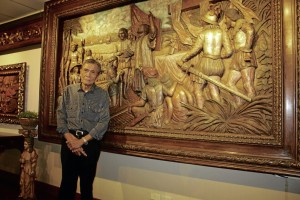Honor overdue for master of woodcarving in Betis

DANIEL Flores stands in front of a wood relief on the first Mass in the Philippines, one of the works of his father, Juan Culala Flores. TONETTE T. OREJAS/INQUIRER CENTRAL LUZON
GUAGUA, Pampanga—The man, acknowledged to have revitalized woodcarving in Betis, elevated this into an art and generated employment in his community, is drawing attention once more.
But the renewed interest on the work and life of Juan Culala Flores, whose creations adorned churches, homes and even Malacañang, came 20 years after his death at the age of 92 in 1992.
The Center for Kapampangan Studies (CKS) has established at Holy Angel University (HAU) a permanent museum for the works of Flores. Opened on Sept. 29, it sits next to a permanent museum of the works of National Artist Vicente Manansala, a Kapampangan from Macabebe.
The Pampanga and Guagua governments, in separate resolutions, supported the nomination of Flores to the Order of National Artists Award, Guagua Councilor Anthony Torres said.
Posthumous
Article continues after this advertisementIn 2007, St. James Parish, through artist Ruston Banal, put up Betis Museum, which has a section featuring Flores who carved the entrance of Betis Church, a national cultural treasure.
Article continues after this advertisementThese efforts converged recently, seeking the posthumous recognition of the sculptor.
“Juan Flores deserves to be declared a national artist. In fact, it is 26 years overdue,” Dr. Arlene Villanueva, HAU president, said in a recent program honoring Flores.
Daniel, Flores’ only son, said the People Power Revolution in 1986, which toppled dictator Ferdinand Marcos, got in the way of his father becoming a national artist that year.
As his father’s assistant, he remembered that then first lady Imelda Marcos was so amazed by his father’s work in Malacañang that she had an exhibit of Juan Flores’ works put up ahead of the supposed recognition.
Forgotten
In 1986, Flores was already paralyzed after suffering from a stroke in 1979.
“I lost the telegraph through which Imelda informed me that the exhibit had been canceled. Then they fled to Hawaii and the honor due my father never came,” Daniel, now 76, told the Inquirer.
He said he has no way of confirming if his father was nominated for the recognition during the Marcos dictatorship or if current efforts are for renomination.
“It is fitting and proper to honor this man forgotten by a culture he has enriched,” Daniel said.
“The thriving woodcarving, furniture-making and ecclesiastical art industries for which Betis is known today can be directly attributed to Juan Flores,” said Robby Tantingco, CKS executive director.
Daniel said his father left Paglalabuan (now Barangay Sta. Ursula) at 16 because he did not like to live on fishing. Often, Flores was spanked by his parents because he wasted time molding figures from mud while boys his age fished.
Quiapo start
The barge that Flores took sailed for Manila, where he found work in the studio of carver Maximo Vicente on Hidalgo Street in Quiapo. After three years, he became Vicente’s chief foreman. After three more years of working with major sculptors, he returned to his village, teaching woodcarving techniques to boat makers, carpenters and artists.
Among his students were Manansala, Antonio Galleron, Antonio Dumlao, Bernabe Flores, Ronnie Cruz, Leopoldo Lugine, Alfredo Santos and Allan Cosio, a 2004 article on the National Commission for Culture and the Arts website said.
Daniel said Flores began carving the walls, doors and ceilings at Malacañang’s Kalayaan Hall after the late President Manuel Quezon praised him for making his bust.
Daniel said his father won in several international competitions, and Flores particularly liked the one held in Washintgton, DC, in 1971 because he bested 60 artists. Tonette Orejas, Inquirer Central Luzon